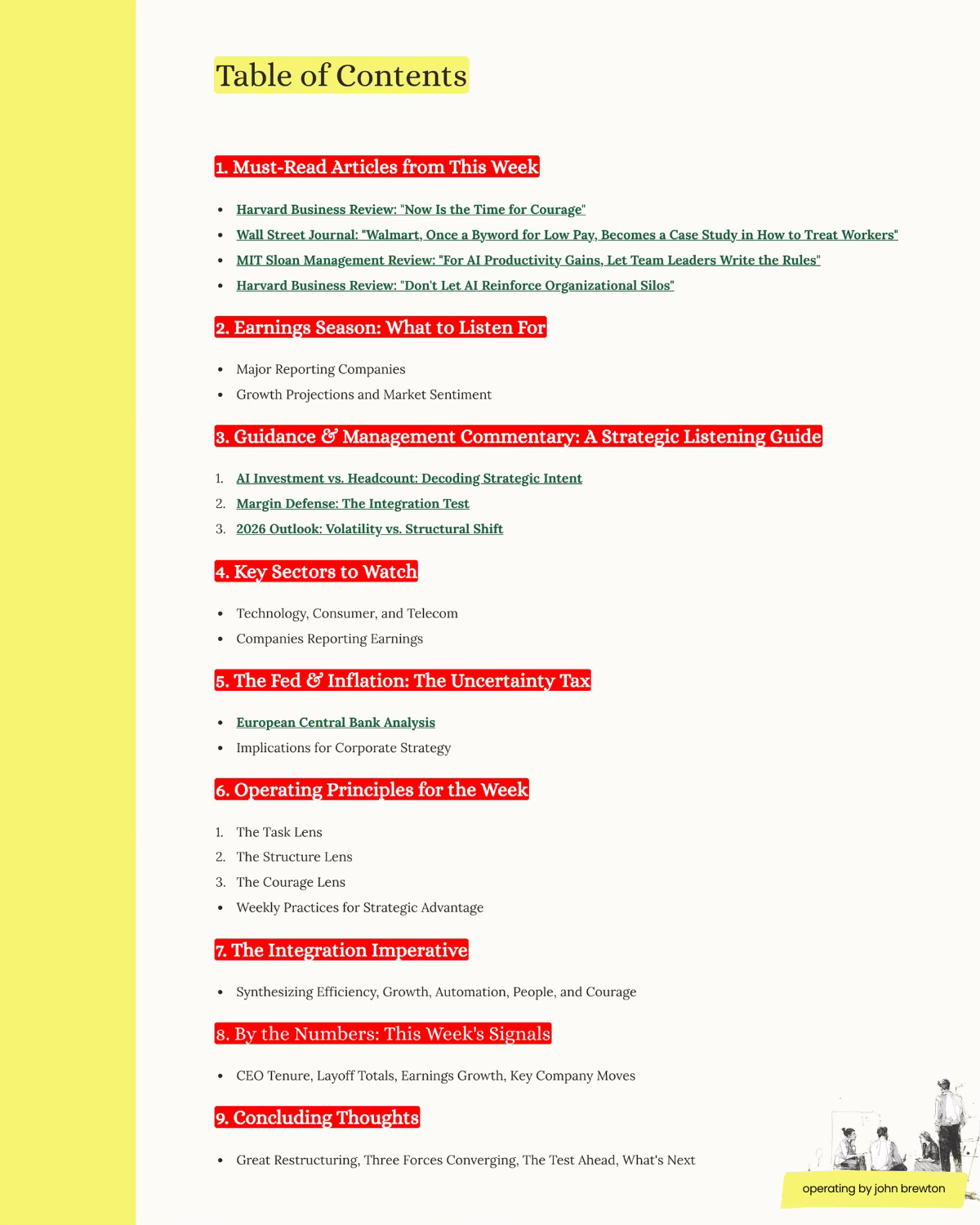The Operating Week Ahead: 10.19.25 to 10.26.25
What Happened, What's Ahead & What We're Reading
Welcome to this week’s Operating Note your essential briefing on the forces reshaping corporate strategy and market dynamics. This weekly analysis synthesizes major market and restructuring announcements, earnings season signals, central bank policy developments, and leading academic research into actionable intelligence for executives, strategists, investors (Operators) navigating an environment of accelerating transformation. Each Sunday evening, Operating by John Brewton delivers this deep-dive synthesis exclusively for our paid subscriber community to help prepare your thinking for the week ahead.
More than anything, we simply hope this helps your work. Please let us know if there’s anything we could add or focus more squarely on to provide additional, actionable strategic value.
Must-Read Articles from This Week
Harvard Business Review: “Now Is the Time for Courage”
In an era of accelerating disruption and compressed strategic cycles, organizational courage has shifted from leadership virtue to competitive necessity. HBR’s research on the 2008 crisis reveals that just 9% of companies emerged significantly stronger—distinguished by their willingness to simultaneously cut costs and make bold growth investments rather than choosing one or the other. The article dismantles the false choice between caution and risk, arguing that systematic courage can be cultivated through deliberate practices: supporting intelligent experimentation, rewarding calculated risk-taking, and building cultures that challenge rather than reinforce the status quo. Most powerfully, it demonstrates that in volatile environments, the cost of waiting for clarity exceeds the risk of decisive action—a principle that separates market leaders from those left managing decline.
Wall Street Journal: “Walmart, Once a Byword for Low Pay, Becomes a Case Study in How to Treat Workers”
Walmart has executed one of corporate America’s most dramatic strategic repositions—transforming from the poster child for wage suppression into an unexpected standard-bearer for worker investment. Through systematic increases in wages, comprehensive benefits expansion, and structured development pathways, the retail giant turned labor economics into competitive advantage: lower turnover translates to superior customer experience, operational knowledge retention, and ultimately stronger financial performance. The article’s deeper insight challenges conventional wisdom about the automation-versus-people trade-off, showing how Walmart’s bold bet on human capital created differentiation competitors struggle to match even as they deploy comparable technology. This isn’t corporate social responsibility—it’s strategic courage yielding measurable returns in a sector where most players still treat labor purely as a cost to minimize.
MIT Sloan Management Review: “For AI Productivity Gains, Let Team Leaders Write the Rules”
This research fundamentally challenges the centralized IT-driven model dominating AI deployment, demonstrating that real productivity gains emerge when organizations empower those closest to actual work. The article’s core insight: AI tools are context-dependent—what optimizes one workflow may fragment another, making domain expertise more valuable than technical standardization in configuration decisions. Companies achieving measurable results build “learning infrastructure” rather than deployment mandates, creating guardrails for experimentation while delegating implementation authority to team leaders who understand operational nuance. The strategic connection to organizational flattening is explicit—as hierarchies compress and middle management disappears, distributed decision-making shifts from preference to necessity, and AI adoption becomes the test case for whether companies can operate without traditional command-and-control structures.
Harvard Business Review: “Don’t Let AI Reinforce Organizational Silos”
HBR exposes the counterintuitive reality that most AI implementations—74% according to enterprise research—actively strengthen the organizational dysfunction they’re meant to solve. When departments deploy AI independently, they create competing recommendation engines generating conflicting strategies: marketing’s AI suggests one approach, sales’ contradicts it, operations’ demands a third, leaving executives paralyzed by algorithmic certainty pointing in different directions. The article’s prescription is architecturally demanding but operationally clear: successful AI transformation requires unified data infrastructure, cross-functional governance from inception, and customer-journey-first design that forces integration rather than allows fragmentation. The deeper strategic warning resonates beyond technology—companies using AI to optimize existing silos are automating their way to faster, more confident failure rather than building the integrated intelligence needed for adaptive capacity in volatile markets.
Earnings Season: What to Listen For
Next week brings one of the most concentrated periods of major company reporting: Tesla, General Electric, Procter & Gamble, Netflix, IBM, Intel, AT&T, Verizon, and Coca-Cola all release results.
Keep reading with a 7-day free trial
Subscribe to Operating by John Brewton to keep reading this post and get 7 days of free access to the full post archives.



